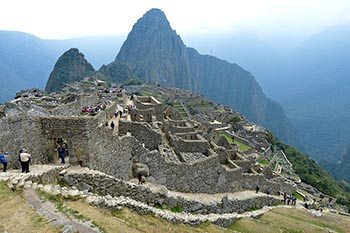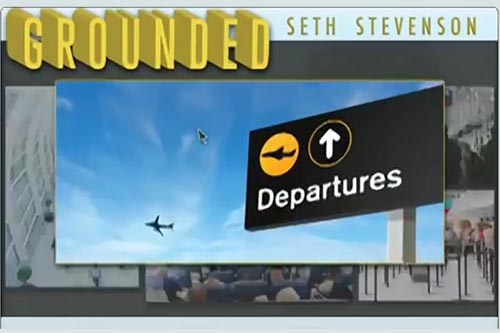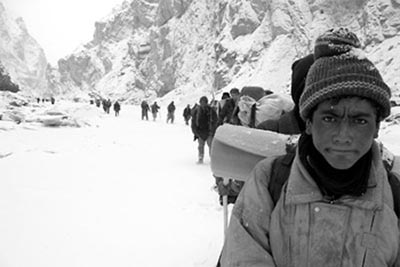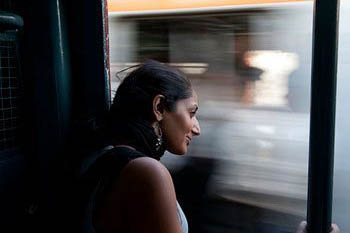
15 countries over 10 months
Turning Left Around the World is for those of a certain age who have rid themselves of the ‘cash-rich time-poor’ restraint and seek adventure. But prefer to turn left when boarding, choose a one-to-one specialist guide rather than a bus full and enjoy a room with a sea view rather than a room with a shared loo.
It is the story of David and Helene’s adventure across 15 countries over 10 months; every chapter has its own story to tell, often surprising, frequently funny, and occasionally tragic.

For some people, retirement dreams consist of comfy slippers and gardening. Not so David and Helene, whose dream was of adventure. They presented Audley Travel, with the challenge of exploring the history, landscape, wildlife, people, and food in fifteen countries over ten months.
Turning Left Around the World is an entertaining account of their adventure. Share their adventure, enjoy the surprises and meet some fascinating people with some unusual customs.
David’s conversational style of writing is full of amusing anecdotes and observations from some remarkable experiences and unusual encounters whilst providing an insight into the culture, history, food, and wildlife of each destination.
So, ‘Turning Left Around the World’ is about an ordinary couple on an extraordinary journey most over 50’s want to take, to explore, dream and discover. It should be essential reading for those whose nest is empty but wanderlust is full. Discover more about their adventure at www.davidcmoore-author.com
Excerpt from the Book:
Day 51 – 55: PERU
Machu Picchu: There’s a Hidden Castle in the Sky where the Kings Live

There is no road to Machu Picchu, so we booked ourselves onto the Perutravel Vistadome train.
It was rush hour and all manner of trains were passing through, blowing their whistles and horns to attract the attention of the hundreds of bewildered waiting passengers. The journey was 90 minutes and took us through an ever-changing dramatic scenery as it hugged the torrent of the Urubamba River that snakes its way through the narrow Sacred Valley.
We left the barren mountainous slopes and the vegetation became green, lush, and lofty, forming a tunnel around our train as we entered the humid rainforest. After passing some teaser Inca ruins we entered the town – the train stopped right in the middle of it, no station just the market on one side, shops, restaurants and hotels on the other.
‘From there it’s straight-up by bus to the Inca’s Lost City,’ said our guide Saiber, pointing at a procession of tatty old coaches.
‘But don’t sit at the back, it’s too bumpy with too many bends and they drive too fast. You’ll fall on the floor.’ Okay, good advice. We were all good to go up the 1,000 meters to 2,430 meters and one of the highlights of our Peru trip.
After jumping the queue on arrival – Saiber our professional queuer is rather good at this – we began the climb to the plateau for the first sight of the ruins in the classic image we have all seen in books and on websites.
Saiber let us go ahead to stand on a grassy ledge looking down on the remnants of the citadel and across to the Piton-shaped mountain known as Huayna Picchu (young peak). I guess he knew what was coming. Helene burst into tears.
‘I’m so sorry, Saiber,’ she sobbed, as I held her tight.
‘It’s fine,’ he said, ‘it happens all the time. I had the same reaction the first time I saw it as a student. Its beauty is breathtaking and often quite overwhelming.’
I’m not sure completely why, maybe it was the serenity of the place, the view itself, the sad story behind Machu Picchu or that it represented exactly why we made this decision to give up our comfortable lives and take on this extraordinary 10-month adventure.
Helene was pretty much inconsolable for the next half an hour or so as more and more of this absurdly impossible and spectacularly beautiful place and its history revealed itself, both visually and in a compelling narrative from Saiber.
While the Inca king, Pachacutec was launching initiatives that were years, if not centuries, beyond his time he also had the foresight to create a defensive strategy. What if they were to be invaded by, let’s say the Spanish for example, who had been planning their visit to America with Columbus and probably had their greedy eye on Mexico and then South America?
Typical Pachacutec vision I reckon. He instructed his R&D department to scrutinize the area within 100km of the capital city Cusco to identify a defensible area they could retreat to if there was an invasion. Seems to me Pachacutec was thinking when not if. His brief had three strategic requirements: it must be geographically impregnable, provide a natural water supply, and have innate resources to enable them to build a small self-sufficient city.
Machu Picchu met all the criteria. Firstly, it was at an elevation of 2,500 meters at the end of the valley, so it could only be approached via a very narrow and exposed trail through the gorge where our train had taken us, then almost vertically up to the plateau. The plateau itself was wedged between two mountains north and south with sheer drops of 300 meters and 400 meters on the east and west down to the river that almost formed a full 360-degree moat.
Pretty tough to conquer even for the Spanish Conquistadors. The natural and plentiful water supply came from the mountain springs. Of course, Pachacutec took full advantage creating viaducts across the citadel, his own private spa, sixteen showers for villagers, and the first en-suite, as Helene pointed out, in the royal residency. Finally, the plateau when found was strewn with giant boulders of granite, ideal for the construction of the various buildings required for self-sufficiency. Mr. P signed it off and work started in 1450.
We spent an intriguing morning wandering around the citadel, the sanctuary for the chosen few. Perhaps the most important structure was the Temple of the Sun where only priests and higher nobles were allowed to enter. It is a semi-circular building sitting on a vast granite boulder, with its two windows aligned to the summer and winter solstices.
The Temple of the Condor was equally impressive. At first, you see a low altar of smooth flat rock shaped in the head of a bird, this was used for sacrifices of a llama. Then, as you take a few steps back from the altar you begin to make out the vast wings of the condor formed naturally by two diagonal outcrops of rock towering 10 meters over the temple entrance. Saiber told us that mummified human remains were found there, it was believed then that the condor soaring high in the sky took the souls of the recently departed to heaven.
The Southern Cross stone was the Incas early attempt at astronomy and cartography. It is shaped exactly like the constellation we are familiar with in the night sky or on the Australian flag and positioned to identify precisely where the five stars will appear on the horizon.
Their fascination with the stars could also be seen in another building at the highest point in the citadel where Pachacutec had an astronomical observatory built. Clever. Two custom-cut stones about a foot in diameter and shaped like shallow bowls were lined with metal, probably silver, and filled with water. The priests would then observe the stars and celestial bodies in the reflection.
The story of Machu Picchu and indeed the Incas ends almost as impossibly as it began. Sure enough, as Pachacutec predicted the Spanish arrived in Peru in 1532 led by Pizarro and his entourage of Conquistadors in search of the gold and riches he believed, quite rightly, the Inca Empire owned.
The Inca royalty and elite retreated to Machu Picchu and shut up shop, just as Pachacutec had intended. They should have been safe there for years with the natural defenses and the self-sufficient life he had created in their secret hideaway.
The Spanish knew the legend of a hidden castle in the sky where the kings lived but had simply failed to discover it, just as Pachacutec had planned. But in 1572 there was a rumor that the Spanish had identified the location of the citadel and were on their way in. Machu Picchu was abandoned.

The small population deserted their utopia by creating a trail “out the back door” with a bridge constructed over the valley and its 400-meter drop.
They took what they could and having crossed the bridge destroyed it and retreated into the mountains, ending their days at Machu Picchu and extinguishing the last glimmer of the glorious Inca Empire.
As we stood on the path where their escape bridge had been, Saiber recounted the denouement to the 4-day story he had enthralled us with.
The unbelievably poignant and sad end to this story is that Pachacutec had, as always, done a wonderful job. The Spanish never did find Machu Picchu, it was abandoned needlessly. The hidden castle in the sky became the Lost City of the Incas and was left to be reclaimed by the jungle, not to be seen again for nearly 350 years. How dreadfully tragic.
The mystery of Machu Picchu continues to this day and Pachacutec is still keeping us all guessing over 100 years since its modern-day discovery. The Yale sponsored and wonderfully named Hiram Bingham III found the Lost City on 24th July 1911 and removed all 200,000 priceless artifacts left behind at the Inca exodus promising to return them to Peru after analysis. Unfortunately, the contract was lost and over 100 years later Peru is still asking for its property to be returned.
In February 2010 French engineer David Crespy was taking some measurements on a small path never used by tourists or the archaeologists, when he noticed the presence of what appeared to be a door sealed with rocks, at the foot of one of the main buildings.
“This is a door”, Crespy immediately thought, clever engineer. He claims to have been unaware that someone, a funny or bright tourist, or an archaeologist with a sense of humor (doubtful), had written on a stone above the entrance the word “treasure” and drawn an arrow pointing downwards. Bizarre but true.
Crespy and Thierry Jamin, an explorer and historian, a sort of French Indiana Jones – he even has the same hat – applied to excavate the sealed entrance. The Cusco branch of the Ministry of Culture responded with a clear “ninguna possibilidad”.
Who can blame them after that scoundrel Hiram Bingham III ran off with all the treasures last time?
That night we had dinner with Saiber and reflected on what we had seen and heard, still making me swallow hard when I think of the past glory of Pachacutec, his people, what they had achieved and the tragic end. I wondered how different the world would be if the Incas had been allowed to flourish, they achieved so much in such a short time. I have developed a huge amount of admiration for a civilization I scarcely knew; I guess that’s what this adventure was all about.
Buy this book Turning Left Around the World
- Missouri Sports Travel Adventure: From Landmarks to Ballparks - January 21, 2026
- What First-Time Visitors Get Wrong About Visiting Iceland - January 15, 2026
- Bareboat Charter vs all-inclusive Crewed: Which Luxury Charter Fits You? - December 29, 2025








awesome blog! thanks for sharing and keep it up!
Many thanks Kiye Sic, so pleased you like the extract from ‘Turning Left Around the World’
Regards
David